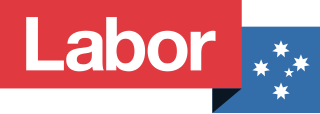
The Australian Labor Party (ALP), also known simply as Labor or the Labor Party, is the major centre-left political party in Australia and one of two major parties in Australian politics, along with the centre-right Liberal Party of Australia. The party has been in government since the 2022 federal election, and with political branches active in all the Australian states and territories, they currently hold government in New South Wales, Queensland, South Australia, Victoria, Western Australia, and the Australian Capital Territory. As of 2024, Tasmania and Northern Territory are the only state or territory where Labor currently forms the opposition. It is the oldest continuous political party in Australian history, having been established on 8 May 1901 at Parliament House, Melbourne; the meeting place of the first Federal Parliament.

The Democratic Labor Party (DLP) was an Australian political party. The party came into existence following the 1955 ALP split as the Australian Labor Party (Anti-Communist), and was renamed the Democratic Labor Party in 1957. In 1962, the Queensland Labor Party, a breakaway party of the Queensland branch of the Australian Labor Party, became the Queensland branch of the DLP.

Kim John Carr is an Australian former politician who served as a Senator for Victoria between 1993 and 2022. Representing the Labor Party, he was a minister in the Rudd and Gillard governments.
Branch stacking is a term used in Australian politics to describe the act of recruiting or signing up members for a local branch of a political party for the principal purpose of influencing the outcome of internal preselection of candidates for public office, or of inordinately influencing the party's policy.

Steven Georganas is an Australian politician and is the Australian Labor Party member for the House of Representatives seat of Adelaide in South Australia since the 2019 Australian federal election. Previously, he had been the member for Hindmarsh from 2004 to 2013 and again from 2016 to 2019.

Australian Young Labor (AYL), also known as the Young Labor Movement or simply Young Labor, is the youth wing of the Australian Labor Party (ALP) representing all party members aged between 15 and 26. The organisation operates as a federation with independently functioning branches in all Australian states and territories which serve under the relevant state or territory branch of the federal Labor Party, often coming together during national conferences and federal elections. Young Labor is the oldest continuously operating youth wing of any political party in Australian history, being founded in 1926.
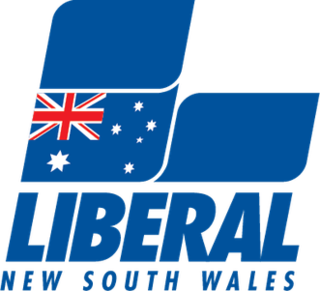
The New South Wales Liberal Party, officially called The Liberal Party of Australia, New South Wales Division, and colloquially known as the NSW Liberals, is the state division of the Liberal Party of Australia in New South Wales. The party is currently in Opposition in New South Wales in a coalition with the National Party. The party is part of the federal Liberal Party.

Lang Labor was a faction of the Australian Labor Party (ALP) consisting of the supporters of Jack Lang, who served two terms as Premier of New South Wales and was the party's state leader from 1923 to 1939. It controlled the New South Wales branch of the ALP throughout most of the 1920s and 1930s. The faction broke away to form separate parliamentary parties on several occasions and stood competing candidates against the ALP in state and federal elections.

Robert Stanley Richards was an Australian politician who served as the 32nd Premier of South Australia, representing the South Australian Branch of the Australian Labor Party.
The Australian Labor Party Caucus comprises all Australian Labor Party (ALP) senators and members of parliament of the current Commonwealth Parliament. The Caucus determines some matters of policy, parliamentary tactics, and disciplinary measures against disobedient parliamentarians. It is alternatively known as the Federal Parliamentary Labor Party (FPLP).
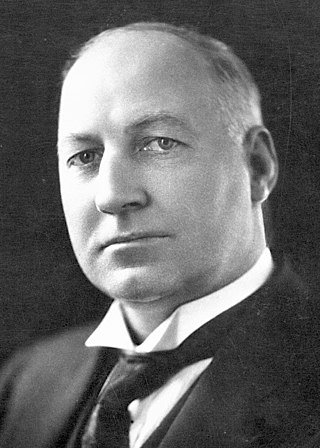
Lionel Laughton Hill was an Australian politician who served as the thirtieth Premier of South Australia, representing the South Australian Branch of the Australian Labor Party.
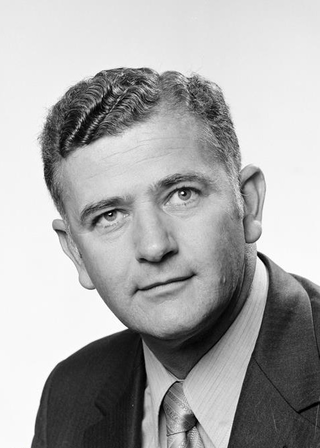
Leonard Joseph Keogh was an Australian politician. He was a member of the Australian Labor Party (ALP) and served in the House of Representatives from 1969 to 1975 and from 1983 to 1987. He represented the Queensland seat of Bowman and later served as president of the Redland Shire Council from 1991 to 1994.

Mark Christopher Butler is an Australian politician. He is a member of the Australian Labor Party (ALP) and has served in the House of Representatives since 2007. He was a minister in the Gillard and Rudd governments and also served as national president of the ALP from 2015 to 2018.
John Andrew Quirke is a former Australian politician. He served as a Senator for South Australia from 1997 to 2000, representing the Australian Labor Party (ALP). He previously served in the South Australian House of Assembly from 1989 to 1997, holding the seat of Playford.

The New South Wales Labor Party, officially known as the Australian Labor Party and commonly referred to simply as NSW Labor, is the New South Wales branch of the Australian Labor Party (ALP). The branch is the current ruling party in the state of New South Wales and is led by Chris Minns, who has served concurrently as premier of New South Wales since 2023.

Stephen Patrick Jones is an Australian politician who represents the Division of Whitlam for the Australian Labor Party. He was elected at the 2010 Australian federal election and is the current Assistant Treasurer and Minister for Financial Services.

Dugald Milton Dick is an Australian politician serving as the 32nd and current speaker of the Australian House of Representatives since 2022. A member of the Australian Labor Party (ALP), he has been the member of parliament (MP) for the division of Oxley since 2016. He previously served on the Brisbane City Council from 2008 to 2016 and as an ALP state secretary from 2004 to 2008.
The Australian Labor Party National Conference, sometimes referred to as the National Party Conference or the Federal Conference, is the highest representative and decision-making body of the Australian Labor Party, incorporating all of the party’s state and territory branches. The National Conference takes place triennially and is hosted in Australian cities on a rotating basis. The 49th and most recent National Party Conference was held on the 17th to the 19th of August 2023 at the Brisbane Convention and Exhibition Centre and was attended by over 2,000 delegates.
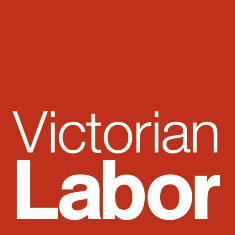
The Victorian Labor Party, officially known as the Australian Labor Party and commonly referred to simply as Victorian Labor, is the Victorian state branch of the Australian Labor Party (ALP). Victorian Labor forms the incumbent government in the state of Victoria and is led by Jacinta Allan, who has served concurrently as Premier of Victoria since 2023.

The Western Australian Labor Party, officially known as the Australian Labor Party (Western Australian Branch) and commonly referred to simply as WA Labor, is the Western Australian branch of the Australian Labor Party. It is the current governing party of Western Australia since winning the 2017 election under Mark McGowan.
















